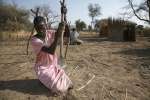African Union Summit
The summit was convened to address root causes and find solutions for displacement; identify ways of preventing forced displacement; improve protection for the forcibly displaced; strengthening measures to meet the specific needs of displaced women and children; devise strategies to reduce the impact of natural disasters as a cause for displacement of people; develop approaches to facilitate the rebuilding of communities emerging from conflict; and enhance partnerships in addressing forced displacement across Africa.
The gathering comes 40 years after the key Organization of African Unity Convention on refugee protection. On the last day of the Kampala meeting, the participants adopted the AU Convention for the Protection and Assistance of Internally Displaced Persons in Africa, which is the first legally binding international instrument on internal displacement having such broad regional scope. The Convention will provide a comprehensive regional framework governing the protection and assistance of IDPs – before, during and after displacement.
The phenomenon of internal displacement continues to expand on the African continent, even as refugee numbers progressively decline. At the beginning of this year, Africa was home to an estimated 11.6 million internally displaced people (IDP), or about 45 percent of the world's IDPs. The continent also has some 2,659,000 refugees and asylum-seekers. Some two million people were newly displaced during the course of last year.
In Photos: The Challenge of Forced Displacement in Africa
15 October 2009
Africa is the continent most affected by the tragedy of forced displacement. While millions of refugees have been able to return to Angola, Burundi, Liberia, Rwanda and South Sudan over the last 15 years, the numbers of internally displaced people have continued to grow. This photo gallery looks at some of the forcibly displaced around Africa, many millions of whom are helped by UNHCR.
-
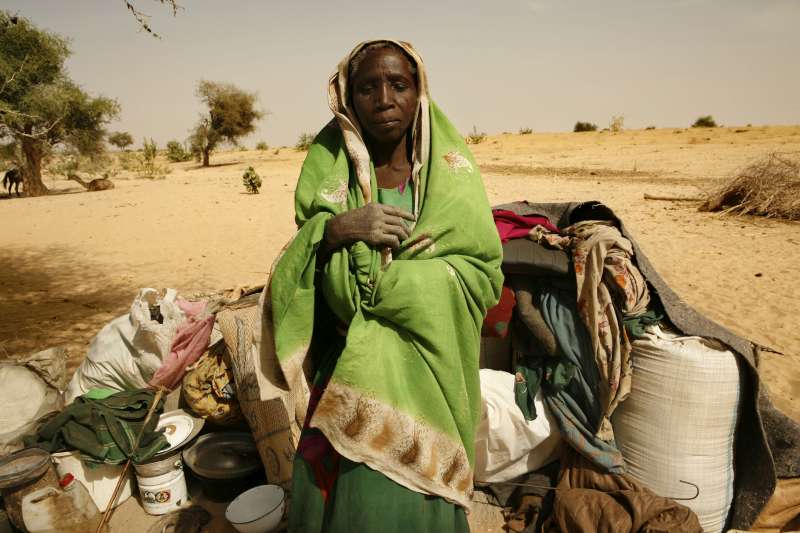 A newly arrived refugee from the Darfur region of Sudan rests next to her belongings in Seneit, Birak area, eastern Chad. © UNHCR/H. Caux
A newly arrived refugee from the Darfur region of Sudan rests next to her belongings in Seneit, Birak area, eastern Chad. © UNHCR/H. Caux -
 Teenager Conwell plays football at the Boy's Shelter in Nancefield, Musina, South Africa. The shelter houses more than 200 boys aged up to 16. Most of the boys crossed the border unaccompanied. They are given food, shelter and lessons. © UNHCR/J.Oatway
Teenager Conwell plays football at the Boy's Shelter in Nancefield, Musina, South Africa. The shelter houses more than 200 boys aged up to 16. Most of the boys crossed the border unaccompanied. They are given food, shelter and lessons. © UNHCR/J.Oatway -
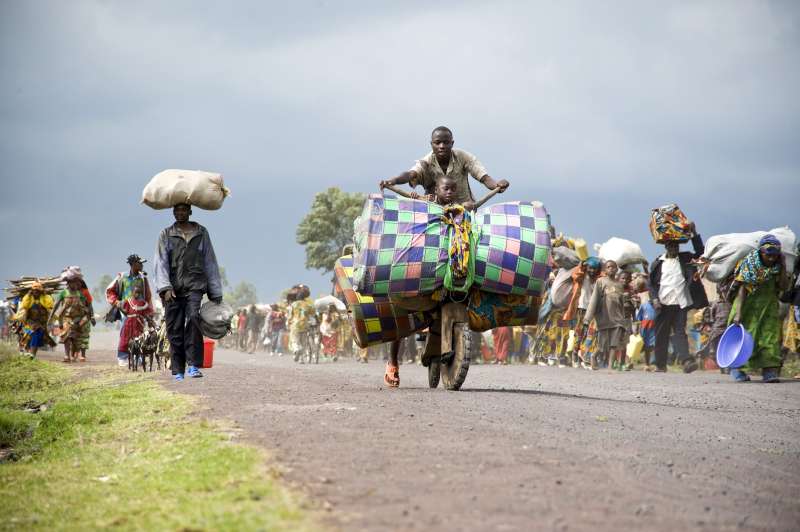 Thousands of people flee the IDP site at Kibati, in Democratic Republic of the Congo’s North Kivu province, after hearing gunfire. © UNHCR/P.Taggart
Thousands of people flee the IDP site at Kibati, in Democratic Republic of the Congo’s North Kivu province, after hearing gunfire. © UNHCR/P.Taggart -
 Continuing violence in Somalia has led to more and more civilians seeking refuge across the border in Kenya, but UNHCR is struggling to cope with the thousands of new arrivals at the camps who need shelter, food and medical attention. ©
Continuing violence in Somalia has led to more and more civilians seeking refuge across the border in Kenya, but UNHCR is struggling to cope with the thousands of new arrivals at the camps who need shelter, food and medical attention. © -
 An internally displaced Liberian family waits to board the truck that will take them home after an aid distribution at Salala IDP camp, Gbarnga. © UNHCR/E.Compte Verdaguer
An internally displaced Liberian family waits to board the truck that will take them home after an aid distribution at Salala IDP camp, Gbarnga. © UNHCR/E.Compte Verdaguer -
 Somali children in the Bulo Jawaanley camp for the internally displaced, South Galkayo, Somalia. © UNHCR/B.Bannon
Somali children in the Bulo Jawaanley camp for the internally displaced, South Galkayo, Somalia. © UNHCR/B.Bannon -
 Makeshift shelters and new tents in a section for new arrivals at Ifo, one of the three refugee camps at Dadaab in north-east Kenya. © UNHCR/E.Hockstein
Makeshift shelters and new tents in a section for new arrivals at Ifo, one of the three refugee camps at Dadaab in north-east Kenya. © UNHCR/E.Hockstein -
 Through a special community empowerment project, these displaced people are building a school, and a roof for the market place in Gbarlatuah Town, Bong County, Liberia. © UNHCR/E.Compte Verdaguer
Through a special community empowerment project, these displaced people are building a school, and a roof for the market place in Gbarlatuah Town, Bong County, Liberia. © UNHCR/E.Compte Verdaguer -
 An Eritrean refugee waits to make a call at a telephone bureau in Kilo 26 refugee camp. On the wall behind him are the call rates for countries around the world. © UNHCR/F. Noy
An Eritrean refugee waits to make a call at a telephone bureau in Kilo 26 refugee camp. On the wall behind him are the call rates for countries around the world. © UNHCR/F. Noy -
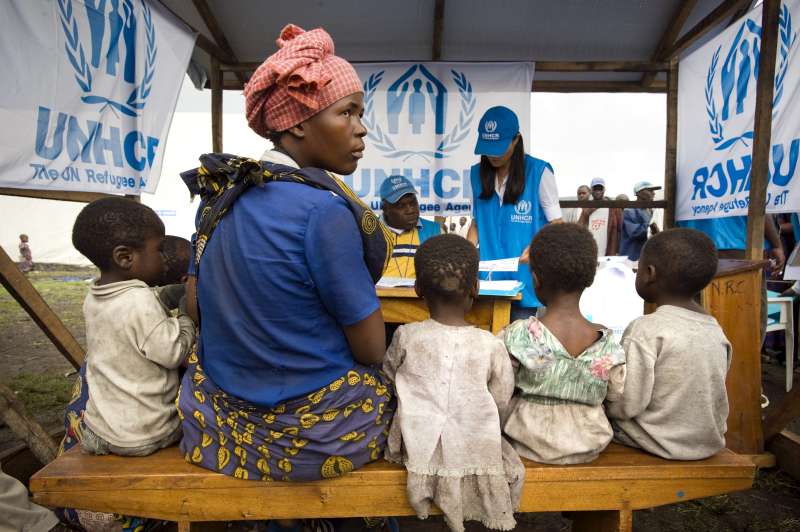 A UNHCR staff member registers a displaced family so that they can move from Kibati IDP site to the Mugunga 1 site in North Kivu province, Democratic Republic of the Congo. © UNHCR/F.Noy
A UNHCR staff member registers a displaced family so that they can move from Kibati IDP site to the Mugunga 1 site in North Kivu province, Democratic Republic of the Congo. © UNHCR/F.Noy -
 Newly-arrived teenage refugees from Eritrea rest in the male reception centre of the Wad Sherife refugee camp in eastern Sudan. © UNHCR/F.Noy
Newly-arrived teenage refugees from Eritrea rest in the male reception centre of the Wad Sherife refugee camp in eastern Sudan. © UNHCR/F.Noy -
 Children from the Central African Republic, who were displaced by an attack on their village, attend class at a bush school near the Chadian border. © UNHCR/H.Caux
Children from the Central African Republic, who were displaced by an attack on their village, attend class at a bush school near the Chadian border. © UNHCR/H.Caux -
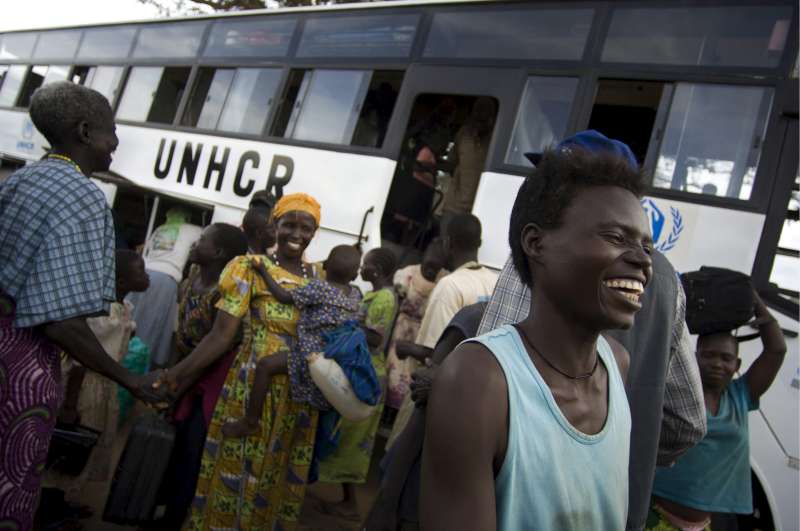 Sudanese refugees celebrate their return to their home village of Moli in South Sudan. Many of them have lived as refugees in Uganda for more than a decade. © UNHCR/Vanessa Vick
Sudanese refugees celebrate their return to their home village of Moli in South Sudan. Many of them have lived as refugees in Uganda for more than a decade. © UNHCR/Vanessa Vick -
 A Sudanese refugee from Darfur pulls up a jerry can filled with water from the main water point in Seneit, used both by the local Chadian population and refugees in the Birak area of eastern Chad. © UNHCR/H.Caux
A Sudanese refugee from Darfur pulls up a jerry can filled with water from the main water point in Seneit, used both by the local Chadian population and refugees in the Birak area of eastern Chad. © UNHCR/H.Caux -
 An internally displaced Congolese child displays his UNHCR arm tag prior to being transferred, along with other vulnerable civilians, to the Mugunga 1 camp in Democratic Republic of the Congo. © UNHCR/P.Taggart
An internally displaced Congolese child displays his UNHCR arm tag prior to being transferred, along with other vulnerable civilians, to the Mugunga 1 camp in Democratic Republic of the Congo. © UNHCR/P.Taggart -
 Every evening, the Central Methodist Church in Johannesburg, South Africa, provides shelter to almost 4,000 Zimbabwean refugees. People sleep wherever they can find space. © UNHCR/J.Oatway
Every evening, the Central Methodist Church in Johannesburg, South Africa, provides shelter to almost 4,000 Zimbabwean refugees. People sleep wherever they can find space. © UNHCR/J.Oatway -
 Newly arrived refugees from Sudan’s Darfur region collect water in a wadi (riverbed) near Seneit in the Birak area of eastern Chad. © UNHCR/H.Caux
Newly arrived refugees from Sudan’s Darfur region collect water in a wadi (riverbed) near Seneit in the Birak area of eastern Chad. © UNHCR/H.Caux -
 Sudanese returnees in Nyamlell, South Sudan, start rebuilding their homes after years in exile. © UNHCR/P.Wiggers
Sudanese returnees in Nyamlell, South Sudan, start rebuilding their homes after years in exile. © UNHCR/P.Wiggers -
 Angolan refugees in the Democratic Republic of the Congo board trucks at Divuma camp for the return home. © UNHCR/S.Hopper
Angolan refugees in the Democratic Republic of the Congo board trucks at Divuma camp for the return home. © UNHCR/S.Hopper -
 A Saharawi refugee from Western Sahara holds her identity documents. © UNHCR/A.Hollmann
A Saharawi refugee from Western Sahara holds her identity documents. © UNHCR/A.Hollmann
People of Concern in Africa
Statistics for the number of displaced people in Africa of concern to UNHCR



















